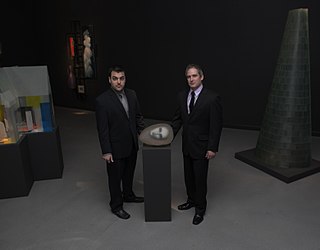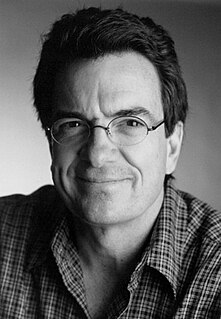Richard Ritter | |
|---|---|
 | |
| Born | 1940 Detroit, Michigan |
| Nationality | American |
| Occupation | Glass artist, teacher |
Richard Ritter (born 1940) is an American studio glass artist who lives in North Carolina.
Richard Ritter | |
|---|---|
 | |
| Born | 1940 Detroit, Michigan |
| Nationality | American |
| Occupation | Glass artist, teacher |
Richard Ritter (born 1940) is an American studio glass artist who lives in North Carolina.
Ritter was born in Detroit, but grew up in the then rural Michigan town of Novi. He was inspired to pursue a career in art by his high school art teacher and in 1959 on to study at the Society of Arts and Crafts (later renamed the Center for Creative Studies) in Detroit, Michigan. In 1962, Ritter left school to take a job with an advertising firm, returning in 1968 to the Society of Arts and Crafts to continue his studies and teach advertising there. His first experience with hot glass came in that year, when another instructor, Gilbert Johnson (b. 1930) [1] built a glass workshop at the school. Ritter graduated from the Society of Arts and Crafts in 1969 and went to the Bloomfield Art Association in Birmingham, Michigan, to teach glassblowing. In 1971 he enrolled in a summer session class at Penland School of Crafts in North Carolina, where his instructor was glass artist Mark Peiser. Ritter soon afterward took a class with Richard Marquis. He then returned to the Penland school the following summer to teach, and in 1973 was named artist-in-residence at Penland School of Crafts, a position that he held until 1978. He continued to return to the school to teach and give workshops in subsequent years. [2]
Ritter moved to Cass, Michigan in 1978. As a professional glass artist he was at this time making murrini vessels and paperweights. A commission from Joan Mondale, wife to then-Vice President Walter Mondale for dessert plates led Ritter to experiment with open platter forms containing murrini and lattacino.
In 1980, Ritter purchased a small farm near Bakersville, North Carolina where he built a studio. In the mid-1980s he began working on his “Triolet” series of large glass sculptures. In 1993 and 1994 he created the 26 art works of his “Grail” series; blown discs to which a faceted solid base was attached. These pieces often displayed etched and copper electroformed surface decoration. He produced 136 glass sculptures in his “Floral Core” series between the years 2002 and 2009; the artist’s "Mandala and Florescence" series was produced in the years 1997 through 2001. [2]
Ritter has been honored with four retrospective exhibitions. In 2009, the fortieth anniversary of his career in glass art was celebrated by an exhibition of 75 works at Toe River Arts Council in Spruce Pine, North Carolina; the exhibition travelled to Western Carolina University in 2010. Lenders to the exhibition included Ritter's colleagues in North Carolina glass Harvey Littleton and Kate Vogel and John Littleton. [3] Exhibitions of Ritter's work at Christian Brothers University in Memphis, Tennessee and at the University of Michigan, Dearborn celebrated the artist's thirtieth year in glass in 1990.
In 1993 the artist was one of 70 artists whose work was selected for “The White House Collection of Craft,” a traveling exhibition organized by the Smithsonian Institution. Other notable group exhibitions in which the artist’s work has been seen include shows at Western Carolina University in 1980, 1982, 1984, 1986; at Habatat Galleries in Michigan in 1981, 1983 1984 and in Habatat Galleries in Florida in 1992. In 1982 Ritter’s work was part of “Detroit Collects” at Detroit Institute of Arts, Detroit, Michigan; “Contemporary Blown Glass by Southeastern Artists at the Museum of Fine Arts, St. Petersburg, Florida and “World Glass Now ‘82” at the Hokkaidō Museum of Modern Art in Sapporo, Japan. His earliest international group exhibition was “American Glass Now” (1979) in Tokyo, Japan. [2]
Ritter was awarded an Honorary Doctor of Fine Arts from the Center for Creative Studies in Detroit, Michigan in 2000. He received a North Carolina Artist Fellowship Grant 2000-2001. In 1984 he received a National Endowment for the Arts Scholarship. [2]
Ritter’s work is in the permanent collections of the Asheville Art Museum (Asheville, North Carolina), High Museum of Art (Atlanta, Georgia), Mint Museum of Art (Charlotte, North Carolina), Hunter Museum of Art (Chattanooga, Tennessee), Corning Museum of Glass (Corning, New York), Detroit Institute of Art, Los Angeles County Museum of Art, Museum of Fine Arts, Boston, Renwick Gallery, Smithsonian American Art Museum (Washington, DC) and St. Louis Art Museum. [4] Alfred Berkowitz Gallery (University of Michigan- Dearborn, Dearborn, Michigan)
Richard Ritter has been married to glass artist Jan Williams since 1977. [2]
Julian Stanczak was a Polish-born American painter and printmaker. The artist lived and worked in Seven Hills, Ohio with his wife, the sculptor Barbara Stanczak.

The Penland School of Craft is an Arts and Crafts educational center located in the Blue Ridge Mountains in Spruce Pine, North Carolina, about 50 miles from Asheville.
Marion M. Bass, known as Pinky Bass or Pinky/MM Bass, is an American photographer, known for her work in pinhole photography.

Dominick Labino (1910–1987) was an internationally known scientist, inventor, artist and master craftsman in glass. Labino's art works in glass are in the permanent collections of more than 100 museums throughout the world. Labino held over 60 glass-oriented patents in the United States.
Alice R. Ballard. is an American ceramicist based in Greenville, South Carolina. Much of her work is characterized by the organic earthenware forms of closed containers, pinch pots, platters, pods, teapots, totems, small work, vessels and a series she refers to as her white work. Much of her work is finished with terra sigillata. Alice considers her art to be “a reflection of [her] relationship with natural forms. It is often the metamorphosis of Nature's forms, as they change from season to season, that attracts her to that universal world in which differing life forms share similar qualities." Her aesthetic heavily references the mother/child/germination metaphor and also explores the more evocative realm of wonder and awe.

David Reekie is an eminent English glass sculptor who uses drawing and glass casting to express his unique vision of the human condition. His art can be found in the Victoria and Albert Museum in London and the Carnegie Museum of Art in Pittsburgh, as well as in several other public collections in the United Kingdom.

Corey Hampson is a United States based author, curator and a director of Habatat.
Ellen Wieske was born in Detroit, Michigan where she continued to live and attend college at Wayne State University. There, she received a BA, and then a MFA from Cranbrook Academy of Art, located in Bloomfield, Michigan. Weiske then went on to teach and work as a metalsmith for over 23 years. She is a member of Society of North American Goldsmiths (SNAG) and resided as a member on the Board of Directors in 2005 and 2006.

Dan Dailey is an artist who, with the support of a team of artists and crafts people, creates sculptures and functional objects in glass and metal.

John Littleton and Kate Vogel are American studio glass artists who have worked collaboratively since 1979. They are considered to be among the third generation of American Studio Glass Movement artists who trace their roots to the work of Harvey Littleton in the 1960s. John Littleton, the youngest child of Harvey Littleton, grew up in the shadow of his father's accomplishments in Madison, Wisconsin, where he experienced first-hand the personalities and events of the early glass movement. Glass, however, was not John Littleton's first medium of choice when it came time for him to select a career. It was only after majoring in photography at the University of Wisconsin–Madison that he began to create in glass. He soon formed a collaborative partnership with another art student, Kate Vogel, who had exchanged her study of two dimensional art for glass. The artists' earliest collaborations in glass were the bag forms for which they are well known today. Since 2000 their work has included a series of arms and hands cast in amber-colored glass. Over the years the hands have held various objects, including river stones, large faceted glass "jewels", and colorful cast glass leaves. In recent years Littleton and Vogel have also become known for their series of functional glass and wrought iron side tables.
Therman Statom is an American Studio Glass artist whose primary medium is sheet glass. He cuts, paints, and assembles the glass - adding found glass objects along the way – to create three-dimensional sculptures. Many of these works are large in scale. Statom is known for his site-specific installations in which his glass structures dwarf the visitor. Sound and projected digital imagery are also features of the environmental works.
Fritz Dreisbach is an American studio glass artist and teacher who is recognized as one of the pioneers of the American Studio Glass Movement.
Linda MacNeil is an American artist working with glass and metal specializing in contemporary jewelry that combines metalwork with glass to create wearable sculpture. Linda is an abstract artist and she works in series. Her focus since 1975 has been sculptural objets d’art and jewelry. “MacNeil has been a pioneer in both the studio jewelry and studio glass movements since the 1970s.” - Museum of Glass. MacNeil’s jewelry is considered wearable sculpture and has been her main focus since 1996. “Designing for the body does add complexity, but I think creating pieces that are ultimately experienced through wearing is a worthwhile challenge that enriches my work. I believe this is something that only jewelry brings to the art of glass.” Linda MacNeil, from Defying Gravity
Alvin D. Loving Jr., better known as Al Loving, was an African-American abstract expressionist painter. His work is known for hard-edge abstraction, fabric constructions, and large paper collages, all exploring complicated color relationships.
Gary Lee Noffke is an American artist and metalsmith. Known for versatility and originality, he is a blacksmith, coppersmith, silversmith, goldsmith, and toolmaker. He has produced gold and silver hollowware, cutlery, jewelry, and forged steelware. Noffke is noted for his technical versatility, his pioneering research into hot forging, the introduction of new alloys, and his ability to both build on and challenge traditional techniques. He has been called the metalsmith's metalsmith, a pacesetter, and a maverick. He is also an educator who has mentored an entire generation of metalsmiths. He has received numerous awards and honors. He has exhibited internationally, and his work is represented in collections around the world.
Norm Schulman was an American ceramic artist who lived in Penland, North Carolina. He was born in New York City in 1924. He operated his own studio, Norman Schulman Studio, in Penland.
Cristina Córdova is an American-born, Puerto Rican sculptor who works and lives in Penland, North Carolina.
Shane Fero is an American artist and glass blower.
Wendy Maruyama is an artist, furniture maker, and educator from California. She was born in La Junta, Colorado.

Cynthia Bringle was born in Memphis, Tennessee, and has lived and worked in Penland, North Carolina since 1970. She is a potter and teaches at the Penland School of Crafts, Anderson Ranch Arts Center, and John C. Campbell Folk School.